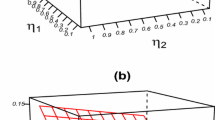Abstract
This paper introduces new estimators for population total and mean in a finite population setting, where ranks (or approximate ranks) of population units are available before selecting sample units. The proposed estimators require selecting a simple random sample and identifying the population ranks of sample units. Selection of the sample can be performed with- or without-replacement. The population ranks of the selected units of with-replacement samples are determined among all population units. On the other hand, the ranks of the sample units of without-replacement samples are identified in two different ways: (1) The rank of a sample unit is determined sequentially among the remaining population units after excluding all previously ranked sample units from the population; (2) The ranks are determined among all units in the population. By conditioning on these population ranks, we construct a set of weighted estimators, develop a bootstrap re-sampling procedure to estimate the variances of the estimators, and construct percentile confidence intervals for the population mean and total. We show that the new estimators provide a substantial amount of efficiency gain over their competitors. We apply the proposed estimators to estimate corn production in one of the counties in Ohio.

Similar content being viewed by others
References
Al-Saleh, M. F. and Samawi, H .M. (2007). A note on inclusion probability in ranked set sampling and some of its variations, Test, 16: 198–209.
Booth, J. G., Butler, W. R. and Hall, P. (1994). Bootstrap methods for finite populations. Journal of American Statisitcal Associaition, 89, 1282-1289.
Dell, T. R., and Clutter, J. L. (1972). Ranked set sampling theory with order statistics backround. Biometrics,28,545-555.
Frey, J. (2011). Recursive computation of inclusion probabilities in ranked set sampling. Journal of Statistical Planning and Inference, 141, 3632–3639.
Frey, J. and Feeman, T. G. (2012). An improved mean estimator for judgment post-stratification, Computational Statistics and Data Analysis, 56, 418-426.
Frey, J. and Feeman, T. G. (2013). Variance estimation using judgment post-stratification. To appear Annals of the Institute of Statistical Mathematics.
Frey, J. and Ozturk, O. (2011). Constrained estimation using judgment post-stratification. Annals of the Institute of Statistical Mathematics, 63, 769-789.
Gokpinar, F., and Ozdemir, Y. A. (2010). Generalization of inclusion probabilities in ranked set sampling. Hacettepe Journal of Mathematics and Statistics, 39, 89–95.
Horvitz, D. G., and Thompson, D .J. (1952). A generalization of sampling without replacement from a finite universe. Journal of Amewrican Statistical Association, 47, 663–685.
Husby, C. E., Stasny, E. A., and Wolfe, D. A. (2005). An application of ranked set sampling for mean and median estimation using USDA crop production data. Journal of Agricultural, Biological, and Environmental Statisitcs, 10, 354-373.
Iwig, W. C. (1993). “The National Agricultural Statistics Service County Estimates Program” in Indirect Estimators in Federal Programs, Statistical Policy Working Paper 21, Report of the Federal Committee on Statistical Methodology, Subcommittee on Small Area Estimation , Washington DC, 7.1–7.15.
Jafari Jozani, M., and Johnson, B. C. (2011). Design based estimation for ranked set sampling in finite population. Environmental and Ecological Statistics, 18, 663–685.
Jafari Jozani, M., and Johnson, B. C. (2012). Randomized nomination sampling in finite populations. Journal of Statistical Planning and inference, 142, 2103–2115.
MacEachern, S.N., Stasny, E.A., and Wolfe, D.A. (2004). Judgment post-stratification with imprecise ranking. Biometrics, 60, 207-215.
McIntyre, G. A. (1952). A method for unbiased selective sampling using ranked-sets. AustralianJournal of Agricultural Research, 3, 385–390.
McIntyre, G. A. (2005). A method of unbiased selective sampling using ranked-sets. The American Statistician, 59, 230–232.
Ozdemir,Y. A., and Gokpinar, F. (2008). A new formula for inclusion probablities in median ranked set sampling. Communications in Statisitcs– Theory and Methods, 37, 2022-2033.
Ozturk, O. and Jafari Jozani (2013). Inclusion Probabilities in Partially Rank Ordered Set Sampling. In review, Computational Statisitcs and Data anlysis.
Ozturk, O. (2014a). Statistical Inference for Population Quantiles and Variance in Judgment Post-Stratified Samples, Computational Statistics and Data Analysis,77, 188-205.
Ozturk, O. (2014b). Distribution free two-sample methods for judgment-post stratified data. In review Statistica Sinica.
Ozturk, O. (2014c). Estimation of population mean and total in finite population setting using multiple auxiliary variables. Journal of Agircultural, Biological and Environmental Statistics, 19, 161-184.
Patil, G. P., and Sinha, A. K. and Taillie, C. (1995). Finite population correction for ranked set sampling. Annals of the Institute of Statistical Mathematics, 47, 621–636.
Stokes, S. L., Wang, X. and Chen, M. (2007). Judgment post stratification with multiple rankers. Journal of Statistical Theory and Applications, 6, 344-359.
Wang, X., Lim, J., and Stokes, S. L. (2008). A nonparametric mean estimator for judgment post-stratified data. Biometrics, 64: 355-363.
Wang, X., Wang, K., and Lim, J. (2012). Isotonized CDF estimation from judgment post-stratification data with empty strata. Biometrics, 68, 194-202.
Wang, X., Stokes, L., Lim, J., and Chen, M. (2006). Concomitant of multivariate order statistics with application to judgment poststratification. Journal of American Statistical Association, 101(476): 1693-1704.
Wolfe, D. A. (2012). Ranked Set Sampling: Its Relevance and Impact on Statistical Inference. ISRN Probability and Statistics, doi:10.5402/2012/568385.
Acknowledgments
The author thanks Cheryl Turner at the USDA NASS Ohio Field Office for arranging to use the Ohio Estimation Data in this study and Christy Meyer at the USDA NASS Head, Census Data Section for providing feedback on an earlier version of this work.
Author information
Authors and Affiliations
Corresponding author
Rights and permissions
About this article
Cite this article
Ozturk, O. Estimation of a Finite Population Mean and Total Using Population Ranks of Sample Units. JABES 21, 181–202 (2016). https://doi.org/10.1007/s13253-015-0231-4
Received:
Accepted:
Published:
Issue Date:
DOI: https://doi.org/10.1007/s13253-015-0231-4




